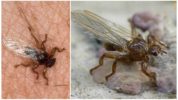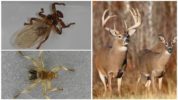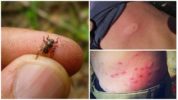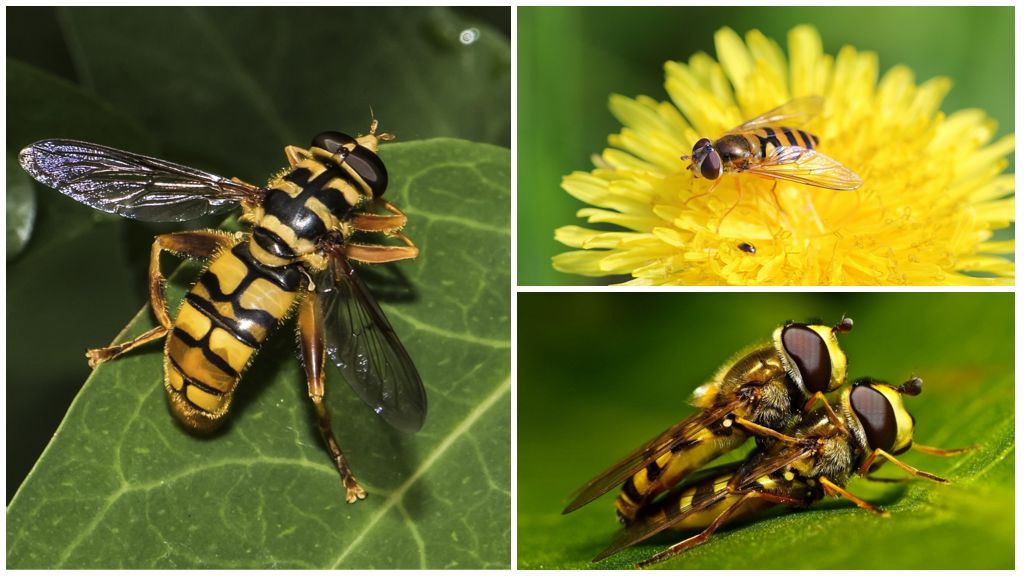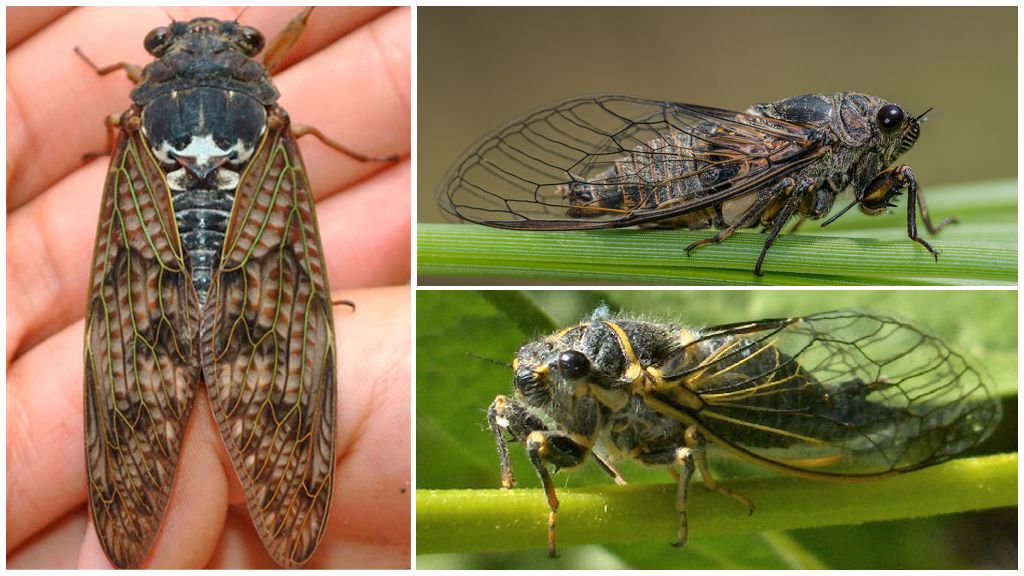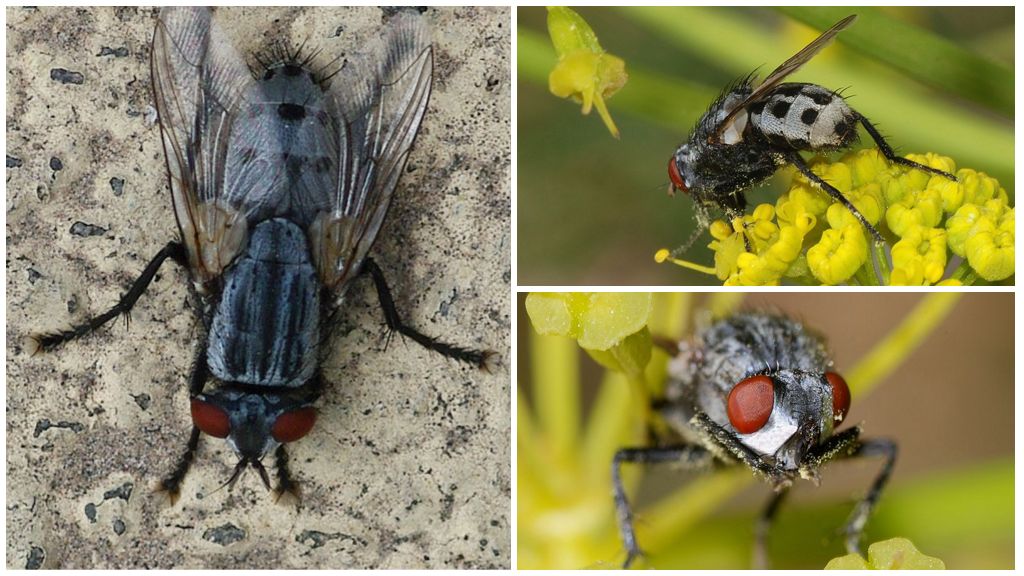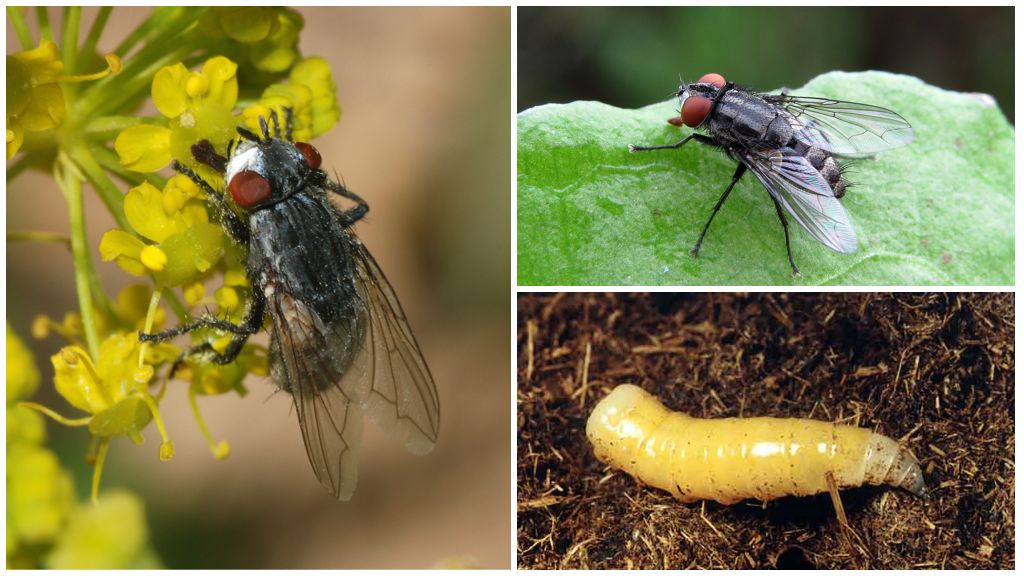- Moose fly
- Danger of a moose fly for animals
- The consequences of a bite of a moose fly in humans
Moose fly has several names - moose, forest flea, louse, tick, deer bloodsucker. It belongs to the genus of a bloodsucker, is a specialized warm-blooded parasite. They feed exclusively on the blood of animals, but under certain circumstances they attack humans, birds, wild animals, and cattle. The main owners are deer, moose, hence the name.
Description of appearance
An amazing creature has similarities with flea, louse, tick, a fly. At a certain stage of development, on the back there is a pair of transparent wings, which reach a length of 6 mm. The insect uses them only to move up, a short distance. Outwardly, it looks like a fly, but after it hits the host’s body, throws off its wings, is more like a flea, a tick.
The body is elongated, up to 3.5 mm in size. Shiny dark cover, flattened shape. Highly visible head with pronounced large eyes. In addition to them, there are 3 more simple eyes on the head.
On a note!
If you do not take into account powerful paws, the creature resembles a flea. But, given how the elk fly claws into the skin, more resembles a tick.
The body is flat with a strong chitinous cover. In a hungry state, the insect is very difficult to crush. As food arrives, as well as during pregnancy, the abdomen greatly increases in size.
The mouthpiece of a moose fly is piercing-sucking, resembles a structure lighter flies. There are a number of hard chitinous bristles on the proboscis, which serve as teeth and help to gnaw warm-blooded skin. A photo of a moose fly is presented below. You can clearly see an amazing creature with a different name.
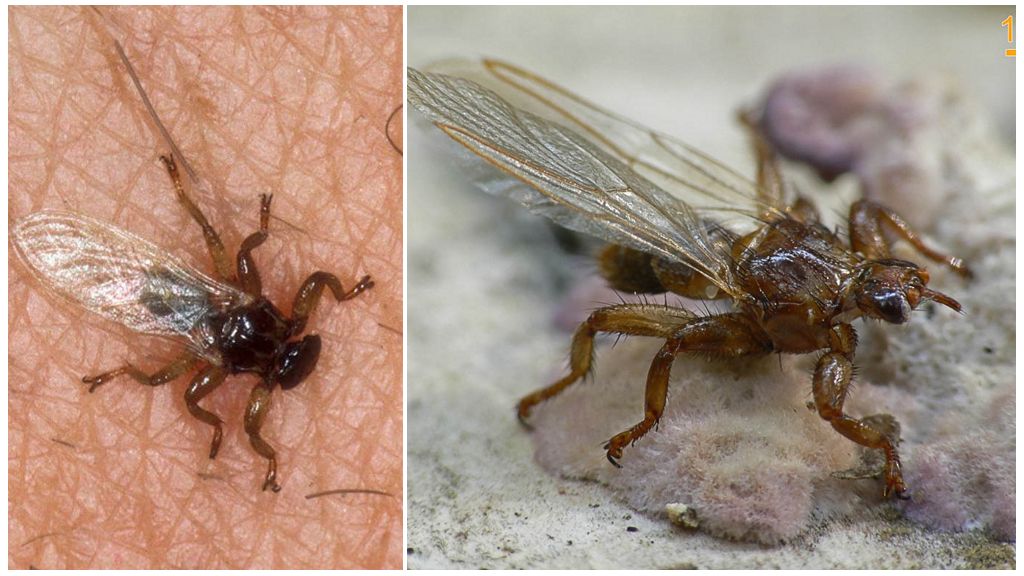
Breeding
The bloodsucker fly is viviparous. Hatching larvae in the abdomen, reproducing matured for pupation into the light. Gives one every every 2-3 days. After mating, the first larva is born in 16-20 days.
Large pre-pupae up to 3 mm in size do not undergo changes, they just harden and fall to the ground. Further fly development continues in forest litter, topsoil. The first puparia appear in late August, in September. Pupae born from October to March continue to develop only with the onset of warm days in the spring, at a temperature of +15 degrees Celsius.
Around the end of August, winged blood-sucking young individuals appear. Moose fly acquires the ability to mate after sucking blood. After 20 days, the first puparia appear, the next are born every 3 days. The life expectancy of adults is 6 months. During this time, one female manages to lay about 30 larvae. The full development cycle lasts 2 years.
Mating takes place on the body of the animal. On one host flat the fly spends all life. Sexually mature individuals are divided into pairs, the male attaches to the body of the female. Only by the beginning of summer moose, deer have the opportunity to completely free themselves from parasites.
Interesting!
In places of feeding and resting of deer, elk, hunters or huntsmen have the opportunity to observe the picture of how the titmouses regale themselves with bloodsucker dolls.They literally fall out of animal hair in colonies. Often found pests on the body of wild dogs, wild boars, bears, wolves, wolverines, as well as birds. Cattle are attacked by pests.
Bloodsucker lifestyle
Forest fly is active during the day. After exiting the pupa, young individuals hide in the grass, on low bushes. Able to wait for a victim within a month. The approach of animals is determined by smell, movement. They quickly fly up into the air, land on the host’s body.
A deer fly for several minutes examines the "terrain", climbs into areas with a thick long coat of wool - back, neck, drops wings. Clings to the skin with its claws, makes a bite. It is absorbed by the proboscis and sucks out about 1.5 ml of blood at a time. After the first meal, the ability to mate appears.
Harm to animals
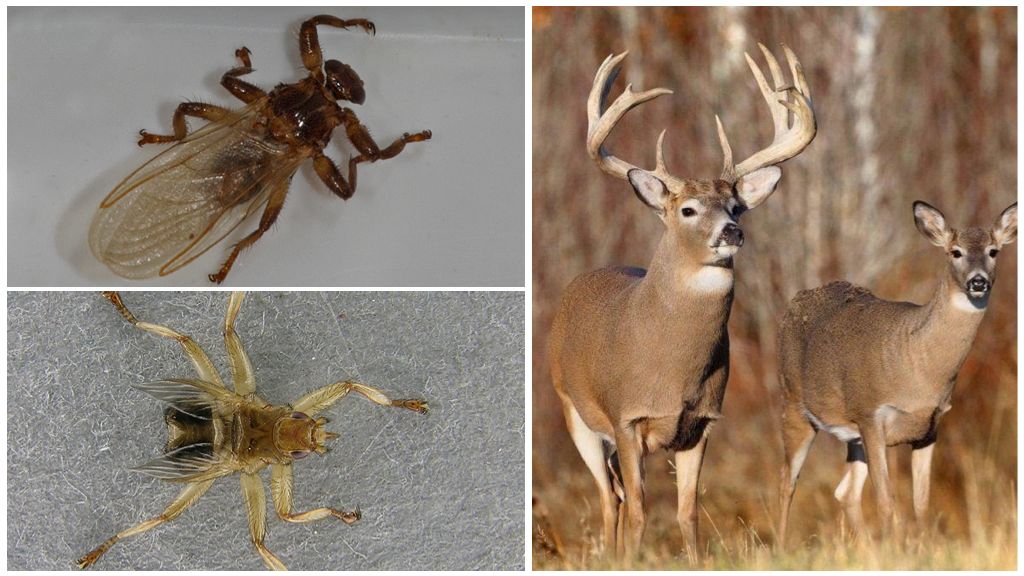
On the body of one deer, hunters totaled up to 300 individuals. The pest is able to stick tightly to the coat, it does not even tear off with teeth.
- The bite of a moose fly causes pain, discomfort, and after a while, inflammation of the affected area, swelling, itching.
- Animals are sensitive to the attack of parasites, sleep poorly, lose strength.
- In domestic cows, the amount of milk is reduced, meat breeds of cattle lose weight.
- A tick-like fly is especially dangerous for young animals. With severe infection, the calves get sick, lag behind in development, even die.
- Wool is taken in lumps and becomes sloppy. An infection often gets into the wounds, suppuration begins.
- During the day, the female eats about 20 times, drinks about 1.5 ml of blood in one procedure. With a strong infection, young growth dies from anemia, adult individuals become weak, painful.
On a note!
Deer bloodsucker does not tolerate diseases, but causes damage to health through its vital functions.
Human parasitism
Pests, hunters, huntsmen, ordinary nature lovers are regularly attacked by pests. Waiting for the victim, the moose fly responds to movement, the smell of sweat. Up to 120 flies can attack one person at a time. They cling tightly to clothes, are not afraid of sudden movements, make their way to the body, climb into their hair. They start to bite after 15-60 minutes.
Interesting!
Elk mites practically do not attack small children under the age of 10 years. If a teenager is next to an adult, his fate will pass. Pests prefer large casualties.
In the case when the fly stuck to the hair, it could be detected after a few days, when itching, painful sensations appeared. In other parts of the body, the parasite is much easier to find. Moose flies in the hair can be from a few days to a week. When combing, they cling tightly, it is difficult to remove.
Than dangerous moose fly for humans

Fly bite each person causes an individual reaction. Some victims note painlessness, others indicate severe discomfort at the puncture sites. In most cases, a swelling, redness appears on the body. It is accompanied by an unpleasant itch. Passes within 7-14 days without special treatment. It can bite in areas where the skin is the thinnest.
People with excessively sensitive skin, an increased tendency to allergies develop a reaction of varying severity. A rash, redness, inflammation, and itching appear. With frequent scratching, pathogens enter the wounds, a secondary infection joins. Other painful symptoms after bites of a moose flea are not observed. Body temperature does not rise, upset stomach and intestines do not appear.
On a note!
A flat fly in an apartment does not live for a long time. Human blood does not allow the development of larvae. Therefore, staying in a person’s house is always random and temporary.
The elk fly lives on the same animals as ixodid ticks, so it can be a carrier of Lyme disease. In the process of special studies in the body of hungry winged females, pathogens were detected in 27% of cases.
How to get rid of a bloodsucker
In order to prevent the moose fly from getting on the body, you need to dress properly when going to the forest. The body should not have open areas, a jacket, trousers with tight cuffs, a hat.
Upon returning home, throw all the clothes into the wash, as a moose fly may stick there. Inspect the body. If a pest is found, throw it into a fire or a jar of alcohol, then throw it away. Take a shower, wash your hair, carefully comb through the locks.
On a note!
An elk tick is attracted as well repel some odors. Do not use perfumes with a sweet aroma, it is better to drop a cologne with a pungent odor on the skin. Essential oils of lavender, citrus, mint, lemon balm, rosemary are suitable for deterring. Apply to clothes.
Insecticidal repellents are used to protect against deer bloodsuckers. Any remedy for ixodid ticks, flies, fleas is suitable. Effective drugs - Taiga, Raptor, Raid, Off, Cypermethrin 25.
Regarding animals, it is completely impossible to prevent the attack of pests, but the timely reaction of the owner, the adoption of emergency measures, protects cattle from serious consequences. Use repellents or folk remedies.
They treat the bites of a moose fly in the same way as other harmful insects. Wipe the sore spot with ice cubes, medical alcohol, ammonia, aloe juice, chamomile broth. Lubricate with an asterisk balm, menovazine. In the presence of an allergic reaction, antihistamines are taken, sore spots are treated with antiallergic ointments.
